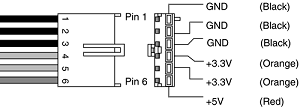ATX Auxiliary Power Connector
As motherboards and processors evolved, the need for power became greater. In particular, chipsets and DIMMs were designed to run on 3.3V, increasing the current demand at that voltage. In addition, most boards included CPU voltage regulators that were designed to convert +5V power into the unique voltage levels required by the processors the board supported.
Eventually, the high current demands on the +3.3V and +5V outputs were proving too much for the design of the connectors and terminals. Each of the terminals in the main power connector are rated for 6 amps (A), which allows for a maximum draw of 18A of +3.3V power and 24A of +5V power.
These maximums match the ratings of an approximately 250-watt-rated power supply. Because motherboards with high-speed processors and multiple cards installed could draw more power than that and power supply manufacturers were building supplies with 300-watt and higher ratings, melted connectors were becoming more and more common.
The terminals in the main connector would overheat under such a load. To allow for additional power from the supply to the motherboard, Intel modified the ATX specification to add a second auxiliary power connector for high power draw ATX motherboards and 250-watt or higher rated supplies.
The criteria was such that if the motherboard could draw more than 18A of +3.3V power, and/or more than 24A of +5V power, then the auxiliary connector would be required to carry the additional load. These higher levels of power are needed in systems using 250 to 300 watt or greater supplies.
The ATX Auxiliary Connector is a 6-pin Molex-type connector, similar to one of the motherboard power connectors used on AT/LPX supplies. The terminals in this type of connector are rated for 5 amps per pin at up to 250 volts. The connector is normally keyed to prevent a misaligned connection.

The additional +5V wire allows a total of 29A of +5V to be available to the motherboard, and the additional two +3.3V wires allow a total of 28A of +3.3V power to be available to the motherboard. If your motherboard does not feature a mate for the auxiliary connector then it probably wasn't designed to consume a large amount of power.
In that case, the auxiliary connector from the power supply (if present) can be left unconnected. If your power supply is rated at 250 watts or higher, you should ensure that it has the Auxiliary Connector.
Consequently, if your motherboard is capable of drawing more than 18A of +3.3V power or more than 24A of +5V power, you should also ensure that your motherboard has the mating auxiliary power connector. Using the Auxiliary Connector eases the load on the main power connector and prevents melted contacts.